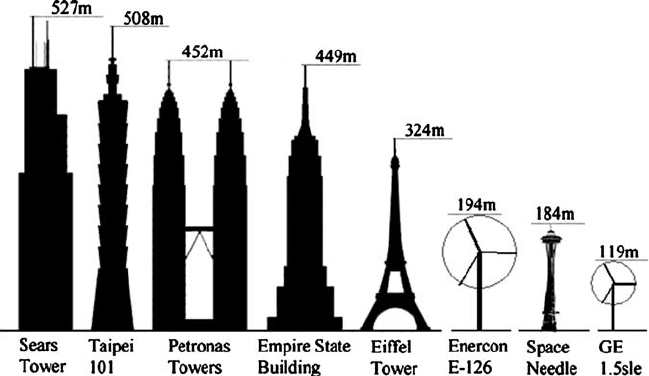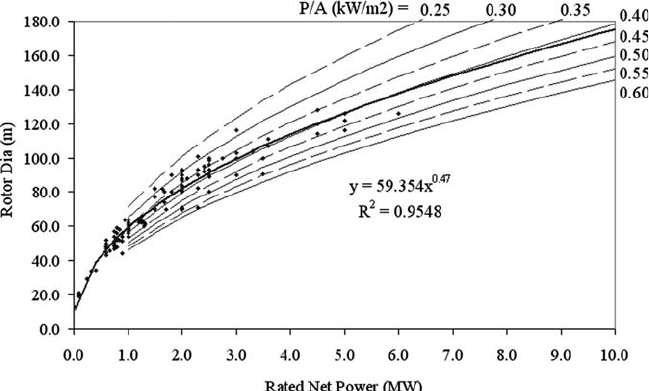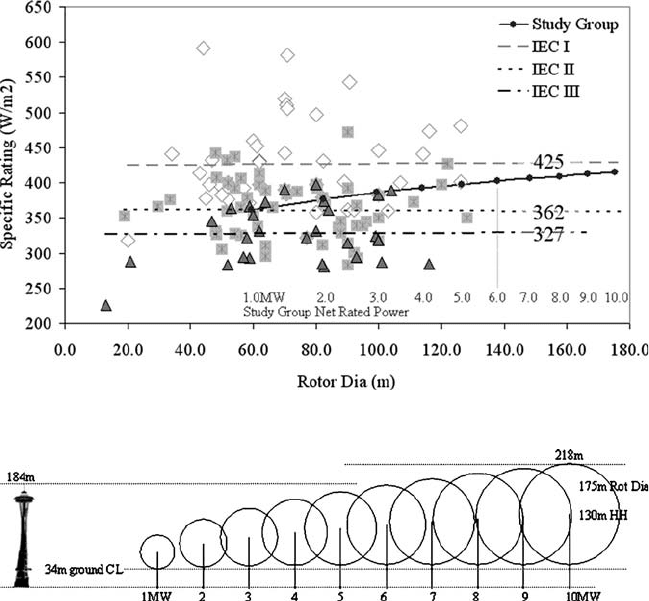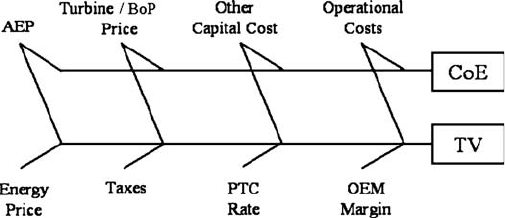Tong W. Wind Power Generation and Wind Turbine Design
Подождите немного. Документ загружается.

PART II
D
ESIGN OF MODERN WIND TURBINES
This page intentionally left blank
CHAPTER 6
Design and development of megawatt
wind turbines
Lawrence D. Willey
General Electric Energy Wind, USA.
Electric power generation is the single most important factor in the prosperity of
modern man. Yet, increasing concerns over carbon emissions from burning f ossil
fuels have brought large-scale renewable energy technologies to the forefront of
technological development. Framework for the successful design and develop-
ment of large wind turbines (WTs) addresses the world’s power generation needs.
The motivation for this work, the broad framework for success, the best approach
for product design, various techniques and special considerations, and develop-
ment aspects are presented. Horizontal axis WTs operating inland or in near-shore
applications are specifi cally addressed.
1 Introduction
Supplies of fossil fuels are inadequate to meet the growing need for more power
generation, which is driven by increasing demand for electricity [ 1 , 2 ]. The hori-
zontal axis wind turbine (HAWT) is one of the most economical forms of modern
power generation. HAWTs have numerous benefi ts: they conserve dwindling fos-
sil fuel resources, reduce harmful emissions, and support a sustainable electric
energy infrastructure for posterity. Large wind turbines (WTs) are an engineering
challenge; they must endure some of the largest numbers of fatigue cycles for
structures while meeting size and cost constraints [49]. New WTs must maximize
reliability, availability, maintenance, and serviceability (RAMS) while having the
lowest cost of energy (CoE) and highest net present value (NPV) for a customer
and an original equipment manufacturer (OEM) [50]. One of the biggest motiva-
tions for accelerating technological development of WTs is in support for the U.S.
20% wind energy by 2030 initiative [ 3 ].
188 Wind Power Generation and Wind Turbine Design
1.1 All new turbine design
What design decisions will make a new multi-megawatt (MMW) WT successful in
today’s power generation market? How big should it be? What are the governing
parameters that drive its design and ensure that it operates without failure and for
the budgeted cost? These are just a few of the many questions at the beginning of
any new turbine design [54]. Providing the lowest CoE in the power generation
market is a challenge to the WT industry, but ever-improving designs are meeting
the challenge. MMW turbines often operate for over 20 years and are among some
of the largest manmade structures, especially from the perspective of controllable
moving parts. An all-new MW WT begins with conceptual design and follows a
rigorous technology building block and toll gate approach for component and sys-
tems development, and then undergoes a validation process involving prototypes
and pre-series projects prior to entering full production. Value analysis or value
engineering drives this process [4 − 6], where cost and fi nancial return are continually
assessed to ensure success for the customer and the OEM.
1.1.1 Technology readiness levels (TRLs)
MW WT technology is advancing quickly, and concepts need to be character-
ized in a way that enables everyone to immediately understand the maturity of a
particular technology. The TRL system (used by NASA and U.S. Government
agencies) provides a common basis for assessing new concepts [ 7 ].
TRL-1: Basic principles observed and reported •
TRL-2: Technology concept and/or application formulated •
TRL-3: Analytical and experimental critical function and/or characteristic •
proof of concept
TRL-4: Component and/or breadboard validation in laboratory environment •
TRL-5: Component and/or breadboard validation in relevant environment •
TRL-6: System/sub-system model or prototype demonstration in a relevant •
environment (ground or space)
TRL-7: System prototype demonstration in a space environment •
TRL-8: Actual system completed and “fl ight qualifi ed” through test and •
demonstration (ground or space)
TRL-9: Actual system “fl ight proven” through successful mission operations •
(space)
1.1.2 Technology proofs required (TRL-1, 2, 3, 4 and 5) − early phase
New turbine development cannot be undertaken effectively using unproven com-
ponent technologies. The best development strategy for new technologies involves
devoted internal research and development (IRD) programs. To mitigate risk, these
programs should be completed before embarking on a new product introduction.
New products released before proper validation and refi nement may result in the
OEM having to mitigate problems later in the fi eld, which can cost the OEM a factor
Design and Development of Megawatt Wind Turbines 189
of 10 or more relative to doing it correctly up front. A roadmap of technologies and
products relative to the marketplace and other manufacturers helps keep upfront
costs down and minimizes overall development cycles. Organizations need not
necessarily have their own IRD departments. There are examples of broad-based
collaborative research programs among industry, university and government par-
ticipants. Value analysis is critically important in understanding research priorities
and where to apply funding. Regular re-evaluation is required to ensure market
changes are refl ected in re-direction or termination of programs.
1.1.3 Technologies in-hand (TRL-6, 7, 8 and 9) − late phase
Having a broad range of component technologies from wind or other sectors (that
are well understood and scalable) is an important aspect of new WT design. Even
with this, system integration readiness should not be underestimated. During the
product development cycle, early assumptions about the suitability of a component
technology may come under question, and new validation steps or even the invention
of new component technology may become necessary. Again, continuous and ever-
improving value analysis is the key activity for assessing technologies in-hand
and identifying new development opportunities. Carrying the value analysis cycles
throughout the development phases will help identify where additional technology
proofs are needed and will ultimately yield the very best product.
1.2 Incremental improvements to existing turbine designs
Once a product is introduced, later market entrants force competition and cause a
need for the original product to improve. Incremental product improvements can
be more tractable for some risk adverse organizations from the perspectives of
quick return on investment (ROI) funding allocation and minimizing investment.
There comes a point in every WT design when up-scaling component technol-
ogy, improving performance or further cost reduction are not possible, and a new
breakthrough design is required to begin the cycle anew [46]. Continual value
analysis provides the foresight needed to know which route to take and when, and
it helps build a comprehensive multi-generation technology plan (MGTP) that is
regularly reviewed and updated.
1.3 The state of technology and the industry
Thirty-fi ve years into the modern WT era, less than half of this experience is in
today’s large utility scale machines. More than 27 GW of new wind capacity was
commissioned worldwide in 2008, a 36% increase over 2007. By the end of 2008,
global wind capacity grew nearly 29% reaching 121 − 123.5 GW with turbine and
wind power plant (WPP) investments worth about US$47.5B (€36.5B) [ 8 , 9 ]. The
state of WT design today is similar to the state of automobile design in the 1920s
and 1930s. Even the most advanced WTs are relatively immature when consid-
ering future advances for component integration, dry nanotechnology, quantum
wires and advanced digital controls [ 1 ]. There are many choices to be made today,

190 Wind Power Generation and Wind Turbine Design
and with tighter R&D budgets and a shortage of qualifi ed wind engineers and
specialists in the industry, there is great opportunity for those who recognize this
view of the future today. The need for more electrical energy is driving installa-
tion of more wind energy. Rapidly increasing numbers of government, university
and industry collaborations are becoming involved with wind energy. All of these
groups are quickly recognizing the importance of value analysis to set R&D
priorities and guide innovation [55].
2 Motivation for developing megawatt-size WTs
Modern WTs have become very large structures that push the limits for structural
engineering and require the use of lightweight, low-cost materials ( Fig. 1 ) [52].
From fi rst principles, the net power rating and size of a turbine grows with
swept area; i.e. rotor diameter raised to the second power. At the same time, the
amount of material (i.e. mass or cost) increases as the cube of the diameter. This is
known as the square-cube law [ 10 ]. Aside from improving energy capture by
accessing stronger winds at higher hub heights (HHs), the original motivation for
going larger in power rating and rotor size was to lower the CoE through econo-
mies of scale. Today’s most common turbine size is within the 2 − 3 MW rating, and
perhaps as high as 4 − 5 MW for some of the newest designs. Larger machines beyond
5 MW should become economically viable with further advances in material and
design technology, but a sudden change is unlikely over the next 5-year period.
To better understand where the large WT market is today in terms of size, an
“industry study set” of key design parameters for more than 150 utility scale tur-
bines is used to characterize trends and provide a basis for setting targets for new
WT designs [ 11 ]. This data is plotted in terms of rotor diameter and rated net
Figure 1: Megawatt-size WTs are large structures.

Design and Development of Megawatt Wind Turbines 191
power in Fig. 2 . Specifi c rating is defi ned as the rated net power of the turbine
divided by the rotor swept area ( P / A ) and is typically used to characterize the over-
all ability of a design to economically extract electrical energy from the wind. The
majority of today’s large WTs have a specifi c rating in the range of 300 − 500 W/m
2
.
The general trend passes from specifi c ratings of less than 400 W/m
2
for machines
below 4 − 5 MW sizes to greater than 400 W/m
2
for WTs above 4 − 5 MW sizes.
This result is due to plotting all the turbines within the study set without regard
for their particular International Electrotechnical Committee (IEC) type class
(TC). See IEC 61400-1 for an explanation of WT design TC [ 12 , 13 ]. In general,
turbines installed in the EU are typically designed to IEC TC3 and turbines for the
U.S. to TC2. Offshore turbines are typically designed to meet the requirements for
IEC TC1. Today’s largest machines are generally for offshore or IEC TC I applica-
tions. These TC1 data points pull the average trend line towards higher specifi c
ratings with increasing rated net power.
To better illustrate this point, Fig. 3 shows the same data plotted by IEC TC,
together with the study group trend line. The TC data shows that today’s utility
scale turbines have specifi c ratings independent of machine size; TC3 turbines
(7.5 m/s) have an average specifi c rating of 327 W/m
2
, TC2 (8.5 m/s) of about
362 W/m
2
and TC1 (10 m/s) at 425 W/m
2
. The standard deviation for these results
is approximately 7%, 10% and 13% for TC3, TC2 and TC1, respectively.
The industry study set dimensions for 10 turbines along the mean characteris-
tic for the 150+ turbine data set are plotted in Fig. 4 . While it cannot be asserted
that turbines in the 5 − 10 MW range will end up having precisely these dimen-
sions, this does help to characterize a reasonable starting point. The tower height,
rotor diameter and rating are consistent with the natural progression of marketable
designs that have so far balanced higher electrical output per kg of material, cost
Figure 2 : Industry study set w.r.t. lines of constant specifi c rating ( P / A ).

192 Wind Power Generation and Wind Turbine Design
of transport to the project site, installation and operations and maintenance (O&M)
costs. More importantly, this generalized set of turbines (herein after referred to as
the 10-turbine analysis group) provides a very useful datum for comparing value
analysis results with actual or derived mass and cost data.
2.1 Value analysis for wind
Based on extensive value analysis experience for a wide range of real project
economics, up-scaling today’s most popular turbine architectures and component
technologies beyond 4 − 5 MW results in unfavourable customer economics. The
very best value analysis procedures today are computerized in a format that allow
individual component owners to keep their models updated. These procedures
ensure that the modules maintain their functionality relative to each other and in
the overall roll-up to the WPP and electrical grid views.
2.1.1 The cost for value analysis
A rigorous value analysis program is an investment that an OEM must make to ensure
that every dollar spent on new WT technologies or products will result in satisfi ed
Figure 3 : Specifi c rating ( P / A ), IEC TC and the industry study set.
Figure 4 : Turbine size geometry for the industry study set.

Design and Development of Megawatt Wind Turbines 193
customers and maximum shareholder value. Not provisioning for a rigorous ongoing
value analysis program is foolish. Experience shows that a value analysis program
with an annual budget of at least 1 − 1.5% of an organization’s overall engineering
budget will establish and maintain the system of continuous innovation and value
assessment needed for successful technology development and new product designs.
2.1.2 Concepts and defi nitions
AEP – Annual energy production; kWh or MWh •
Turbine price – Cost of the WT equipment to the project developer •
BOP price – Cost of the balance of plant to the project developer; everything •
else needed to build a WPP beyond the WT equipment
Other capital costs – Financing terms and requirements •
Operational costs – O&M required to produce and deliver electricity •
CoE – The cost to produce 1 kWh (or 1 MWh) of electricity for a given time; •
e.g. for a given year
LCoE (levelized CoE) – Average CoE over the WPP life; e.g. 20 years •
Energy price – Power purchase agreement (PPA) – wholesale price paid to the •
WPP owner for the electricity produced
Taxes – Paid to local and federal government (in some instances may be an •
income to the WPP owner in the early years of the WPP life)
PTC – Production tax credit; any of a number of government policy incentives •
that provide income to the WPP owner. Typically a function of power production
and over a specifi ed time schedule
OEM margin – The amount of profi t required by the OEM to satisfy shareholders •
and provision for long-term sustainability of the business
Customer value –NPV for the customer •
OEM value – NPV for the OEM •
Total value (TV) – NPV for the customer and OEM combined •
A simplifi ed illustration of the main contributors to value for both the customer
and OEM are shown in Fig. 5 . While hundreds of parameters are considered in a
Figure 5 : Main contributions determining CoE and TV.
194 Wind Power Generation and Wind Turbine Design
complete value analysis for a WT design and its use in an overall WPP, this simpli-
fi ed diagram shows the main framework. As an example, lease payments to a land-
owner for the land the WTs are built upon may be accounted for in the operational
costs, and so on.
2.1.3 Value analysis outline
The most important aspect of new WT and WPP design is the calculation procedure
and the inclusion of all applicable business functions. This is a challenging
task that can only be realized if a considerable investment is made to establish
a digital environment to capture, maintain and continually update these inputs.
An example of a methodology that has been successful in new WT design is
shown below:
Input high level turbine parameters and design driving wind conditions 1.
Select the component technologies that make up the new WT design 2.
Select the WPP size and description governing installation including BOP and 3.
site construction characteristics
Select the territory that the WPP is to be analysed and check the default settings 4.
for the latest permitting requirements, fi nancial terms and policy incentives.
Repeat steps (1) 5. − (4) if a range of design parameters are to be explored
Select any of a number of pre-defi ned WTs from a library of existing products 6.
that you wish to compare the current results
Submit the overall inputs for analysis to compute a wide range of output that 7.
include value metrics such as CoE and TV relative to the pre-defi ned turbines
The analysis method computes loads for the turbine, relates the loads to the
mass required for components to perform for their intended life, and then assigns
the cost required to procure the components and assemble the system. This is all
done in an environment that ensures that component engineers continually update
their physics-based transfer functions for loads and mass, sourcing and advance
manufacturing update their cost data, and fi nance and marketing keep the project
funding and regional settings up to date.
2.1.4 Simplifi ed equations for CoE and TV [ 14 ]
lev lev lev
CoE = (Ops Int prin Dwnpymt)/AEP++ +
(1 )
where Ops
lev
= f (Term, DR, VAT Recovery Interest, Property Tax, Landowner
Royalty, Utilities Cost, Insurance Cost, Interconnect Service Charge, Other
Royalty Performance Bond, Warranty, LTCSA, Machinery Breakdown Insur-
ance, Management Fee, Independent Engineer, Revenue Tax, O&M); Int
lev
=
f (Term, DR, Debt Type, Interest Rate, Takeout Cost, Debt %, Debt Term);
Prin
lev
= f (Term, DR, Interest, PTC Income, Takeout Cost, Debt Term); Dwnpymt =
f (Takeout Cost, Debt %, O&M Cost, O&M Reserve Months, # of Turbines,
Financing Fee %, Other Upfront Fees); AEP = Annual Energy Production, MWh
at the meter (billable)
